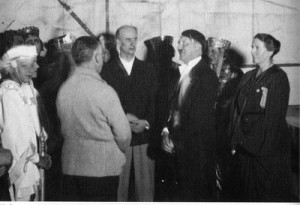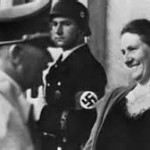 V. BAYREUTH ACCORDING
V. BAYREUTH ACCORDING
TO WINIFRED WAGNER … AND ADOLF HITLER
The Bayreuth era was a singular adventure, under the reign of Winifred, where the little history mingled with the great, where individual personalities, their particular sympathy and ideologies far surpassed the framework of Art for Art and merged with politics and the most delusional compromises.
In his remarkable book, Le Festival de Bayreuth (Sand Edition), Pierre Flinois judiciously compares some aspects of Winifred’s personality with Cosima’s, the other “lady of Bayreuth”: both foreigners, widows and heirs to the direction of the Festival, and surviving their deceased spouses for several decades. Similarities to which one can add a very strong personality, an unconditional love of Richard Wagner’s work, as well as – as history later showed – an uncompromising attachment to tradition, to their tradition, to their unchanging conception of Richard Wagner’s work, the complete opposite of the Master’s the spiritual legacy.
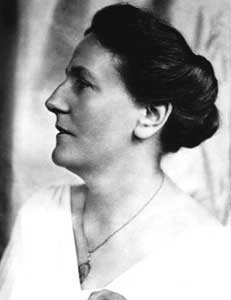 1- Mrs Winifred Wagner
1- Mrs Winifred Wagner
Winifred Marjorie Williams, future Mrs. Siegfried Wagner, was not totally foreign to the Wagnerian furrow. Of English nationality, born on 23 June, 1897 in Hastings, she was the daughter of John Williams, a Welsh writer and theatre critic, and actress and painter Emily Florence (Karop) Williams. Orphaned at the age of two, she moved from one foster home to another before being taken in by a distant German cousin, wife of Karl Klindworth, himself a brilliant pianist, a pupil of Franz Liszt and a composer famous for his piano reduction for the operas of the Master of Bayreuth.
When she was barely seventeen, the young Winifred, who was then called Senta in reference to The Flying Dutchman, met for the first time Siegfried (who was then forty-five) and married him in 1915, in the midst of world conflict. Although a well-known homosexual, Siegfried certainly envisaged thanks to Winifred’s lively and fresh personality – like Ludwig II of Bavaria who thought for a time about marrying Sophie, his cousin Sissi’s sister – to break the burden of silence and curse. For the whole Wagner clan, this news sounded like a deliverance, like a solution to the burden that nobody dared to evoke publicly!
 Just a few months after the wedding, the “victory” was at its height since on 5 January, 1917 was born Wieland: the lineage was now ensured. After Wieland were born Friedelind (1918), then Wolfgang (1919) and finally Verena (1920). And not only did Winifred perfectly fulfill her duties as a housewife, she also became a valuable assistant to her husband Siegfried, while wisely remaining in his shadow.
Just a few months after the wedding, the “victory” was at its height since on 5 January, 1917 was born Wieland: the lineage was now ensured. After Wieland were born Friedelind (1918), then Wolfgang (1919) and finally Verena (1920). And not only did Winifred perfectly fulfill her duties as a housewife, she also became a valuable assistant to her husband Siegfried, while wisely remaining in his shadow.
As social a hostess as her husband could be unassuming, she received with unconcealed sympathy the members of the National Socialist party. Adolf Hitler was one of them: she received the future Chancellor in 1923 in Wahnfried, then his right-hand man, Joseph Goebbels, and, since she shared the convictions displayed by national socialism, she signed up for a party membership as early as 1926.
At this time, Hitler, who devoted a quasi-fanatic cult to the work of Richard Wagner, was received in Wahnfried easily: he shared the daily life of the Wagner family, and became a regular visitor then a part of the intimate circle of the family; the children Wieland and Wolfgang called this strange foreigner “Uncle Wolf“.
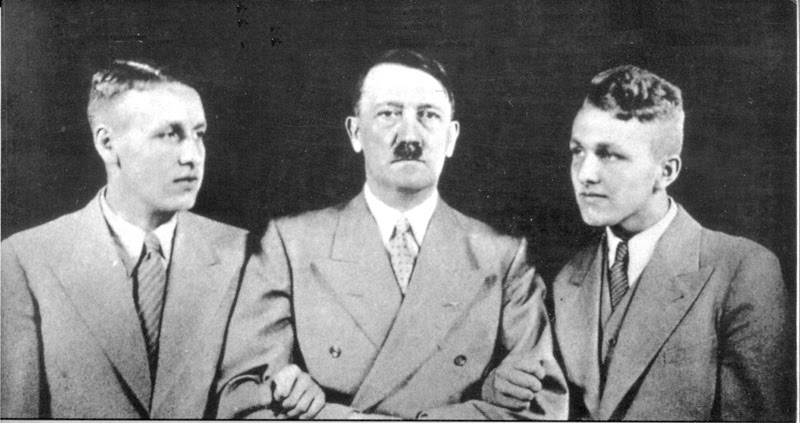
As for Siegfried, he was most often absent from the curious meetings chaired by Winifred, where art and politics already mingled in a worrying way. The relationship between Winifred and Hitler became so strong, so complicit that one could assume a loving relationship between them. But no witness, no trace to certify it.
When Hitler was imprisoned in 1924 in the Landsberg prison after his failed putsch attempt in Munich (his conviction for high treason should have earned him a life imprisonment sentence, but he was sentenced to 5 years, the minimum, and only stayed behind bars for a few months, in a rather comfortable environment), he received nearly 300 visitors and wrote Mein Kampf on the paper sent by… Winifred.
2- Splendours and misery of Bayreuth:
Bayreuth under the Third Reich
On 4 August, 1930, Siegfried passed away. The heir to the Wagner family left behind a legacy as clear as indisputable: “Mrs. Winifred Wagner became heir to the total estate of Mr. Siegfried Wagner. The descendants of the Wagner couple would be the next heirs: with the same rights in case of death or remarriage of Mrs. Wagner” (excerpt from Siegfried Wagner’s will).
This was clear enough not to, theoretically, create controversy! Even though Eva, the enfant terrible of the Wagner couple, married to Houston Stewart-Chamberlain, pointlessly tried to get her share.
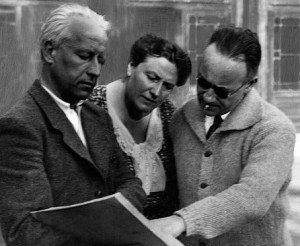 On 18 January, 1931, an agreement was signed between Winifred Wagner, Wilhelm Furtwängler and Heinz Tietjen, who respectively divided among themselves the administrative, musical and artistic direction of the Festival.
On 18 January, 1931, an agreement was signed between Winifred Wagner, Wilhelm Furtwängler and Heinz Tietjen, who respectively divided among themselves the administrative, musical and artistic direction of the Festival.
Thus by calling the director of the Berlin Philharmonic Orchestra (since 1922) and the intendant of the Staatsoper (since 1925) who were the most venerable actors of the German scene at the time, Winifred intended to make those who considered her incapable of solely taking on her husband’s legacy understand that she was now unquestionable in this position.
Although Winifred has always refrained from mixing her personal convictions with the administrative management of the Festival, the fact remains that a number of decisions clearly reflected the Nazi ideology: for example, the progressive exclusion of the Green Hill’s Jewish singers. Hitler, now solely in charge of the entire Germany, moved into Bayreuth no longer as a single guest but as a real master of ceremonies, and the Bayreuth Festival became a showcase for Germanic art as it was celebrated by National Socialism.
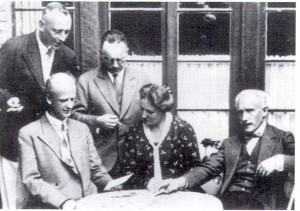 From 1933 to 1939, Winifred reviewed the entire repertoire. Only her late husband Siegfried’s Tannhäuser was still performed faithfully and resisted the new ambient ideology, tinged with a certain modernity. Seconded by his decorator Emil Preetorius, Heinz Tietjen reigned over all the dazzling stage productions that brought a new air from Berlin.
From 1933 to 1939, Winifred reviewed the entire repertoire. Only her late husband Siegfried’s Tannhäuser was still performed faithfully and resisted the new ambient ideology, tinged with a certain modernity. Seconded by his decorator Emil Preetorius, Heinz Tietjen reigned over all the dazzling stage productions that brought a new air from Berlin.
The Wagnerian rearguard, led by the Wagner sisters-in-law, Eva and Daniela, grumbled. But Tietjen had a taste for the grandiose, the ostentatious displays, the celebration, and the cult, which, somehow, ended up seducing people, all finally caught up by the frenzied momentum that animated the crowds during The Berlin Olympic Games or the Nuremberg parades in 1936. The Führer, of course, was the first.
If the staging in Bayreuth did not yet attain the degree of modernity and abstraction that it experienced afterwards with Wieland Wagner, the key words were from then on a taste for the grandiose, large numbers of choirs, as well as musical excellence.
The conductors? The best of that moment: Furtwängler naturally, but also Richard Strauss, Karl Elmendorff and even Victor De Sabata or Franz von Hoesslin. And Heinz Tietjen furthermore granted himself an increasingly big part of the musical direction since 1933.
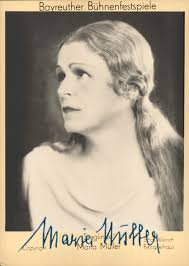 The singers? Of course, the best ones too. At least the ones who were approved by the racial laws of the Reich, the others, mostly exiled, choosing to bring glory to Covent Garden or the Met instead. But on the stage of Bayreuth, it was the triumph of these blond Wagnerian heroes, Maria Müller, Franz Völker, Max Lorenz in exclusively Germanic distributions. With some exceptions, however, such as Germaine Lubin, who would pay a huge amount during the Liberation for her Isolde or her Kundry.
The singers? Of course, the best ones too. At least the ones who were approved by the racial laws of the Reich, the others, mostly exiled, choosing to bring glory to Covent Garden or the Met instead. But on the stage of Bayreuth, it was the triumph of these blond Wagnerian heroes, Maria Müller, Franz Völker, Max Lorenz in exclusively Germanic distributions. With some exceptions, however, such as Germaine Lubin, who would pay a huge amount during the Liberation for her Isolde or her Kundry.
When the war broke out in 1939, just a few days after the end of the Festival, Winifred immediately thought about closing the Festival. She, for the first time, opposed Hitler who wanted for the Bayreuth Festival to play a central role in disseminating the image of Germany around the world… “as if everything was normal.”
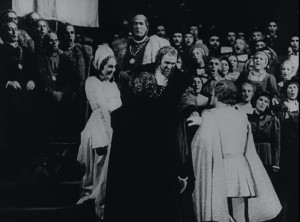 From then on nicknamed Kriegs-Festspiele and intended to boost the troops’ morale while galvanizing the Germanic pride, Bayreuth thus became a propaganda tool, even in the distribution.
From then on nicknamed Kriegs-Festspiele and intended to boost the troops’ morale while galvanizing the Germanic pride, Bayreuth thus became a propaganda tool, even in the distribution.
It was therefore over with the “slightly morbid” sulphurous character of Tristan and the Holy Mass (too religious for the pagan aspirations of National Socialism) in Parsifal; henceforth only The Ring, The Flying Dutchman and The Master-Singers were performed.
The exaltation of a Germanic sentiment (which was none other than the projection of the dictator Hitler himself) thrown as a provocation in the face of the world.
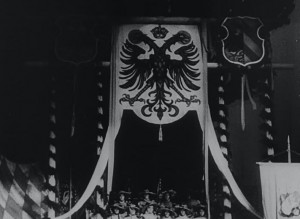 But the Festival offered nothing new either in terms of staging or in the distributions. It progressively settled down again in a routine close to a place of death. Starting from 1943, only The Master-Singers still belonged.
But the Festival offered nothing new either in terms of staging or in the distributions. It progressively settled down again in a routine close to a place of death. Starting from 1943, only The Master-Singers still belonged.
At the end of 1944, the Bayreuth Festival was officially closed. And Richard Wagner’s town fell under allied bombing. This was the end of an era and it took seven years, seven years of reflection before a “New Bayreuth” was considered.
NC/SB
List of reference materials consulted for the realization of Section IV : BAYREUTH
![]()
If you wish to share further information about this article, please feel free to contact us !
